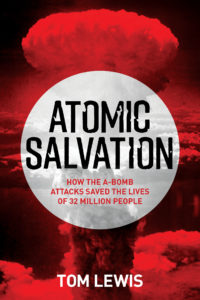- Author
- Book reviewer
- Subjects
- History - WW2, Book reviews
- Tags
-
- RAN Ships
- None noted.
- Publication
- December 2020 edition of the Naval Historical Review (all rights reserved)
Atomic Salvation by Tom Lewis. Big Sky Publishing, Sydney, 2020. Soft cover, 352 pages with b&w photographs. Booksellers at $29.99.
 In this book the author constructs an argument supporting the dropping of atomic weapons on Japan. While these caused horrific suffering and destruction this was to the greater good in bringing the war to an early end and thereby saving the lives of many millions more people. There is still much debate concerning the legal and ethical justifications for thesebombings. This book attempts to answer some of these questions, and in particular the situation of no bombs and an attempted D Day like invasion of the Japanese homeland.
In this book the author constructs an argument supporting the dropping of atomic weapons on Japan. While these caused horrific suffering and destruction this was to the greater good in bringing the war to an early end and thereby saving the lives of many millions more people. There is still much debate concerning the legal and ethical justifications for thesebombings. This book attempts to answer some of these questions, and in particular the situation of no bombs and an attempted D Day like invasion of the Japanese homeland.
The Potsdam proclamation defining terms for a Japanese surrender was issued on 26 July 1945 by the US, UK and China. The document stated that if Japan did not surrender it would face ‘prompt and utter destruction’. By 6 August, there had been no Japanese response to the Potsdam Declaration. Accordingly, President Truman, with the consent of the UK, ordered the atomic weapon attack on Japan.
On 6 August 1945 at Hiroshima, a B-29 Superfortress bomber Enola Gay piloted by Colonel Paul Tibbets, call sign Dimples 82, dropped ‘Little Boy’ which was an enriched uranium gun type fission nuclear weapon. At Nagasaki on 9 August 1945, another B-29 Boxcar piloted by Major Charles Sweeney, call sign Dimples 77, dropped ‘Fat Man’ a plutonium implosion type nuclear weapon.
The atomic attacks on Japan had been preceded by conventional and fire-bombing campaigns. The atomic attacks probably killed around 200,000 people. But better 200,000 should die rather than as many as 35,000,000 as a combined total of all allied and Japanese deaths in a conventional invasion. The allied planners had little doubt in their minds that Japan, although already almost defeated, would fight relentlessly to the death to try to save their homeland. Accordingly, a prolonged battle involving both allied and Japanese military casualties needed to be strongly considered.
The Allies had paid a high price for the defeat of Japanese forces on the offshore island of Okinawa and using this example extends the hypothesis to the impact of an invasion of the Japanese homeland where the defenders might have fought to the bitter end. Also, of consideration was the fate of 300,000 allied POWs as they may have all been executed.
The author postulates that if a nation loses the vast majority of its population from teenage to middle aged adults, it will never again rise from the ashes. If Japanese females from 14 upwards had died in a final defence there would be no one left to bring new lives into Japan, which would have been a smoking ruin, ground to rubble beneath the tracks of armoured vehicles as they rumbled through the devastation. The atomic bombings prevented this and ended the war. If the A-bombs had not been used, the home islands with a population of 73,000,000 could have seen a horrific end with about 28,000,000 killed in the conflict.
Dr. Lewis is to be congratulated for the accumulated evidence presented in Atomic Salvation supporting the hypothesis that the Allies were justified in their atomic attacks on Japan.
Reviewed by Kevin Rickard
